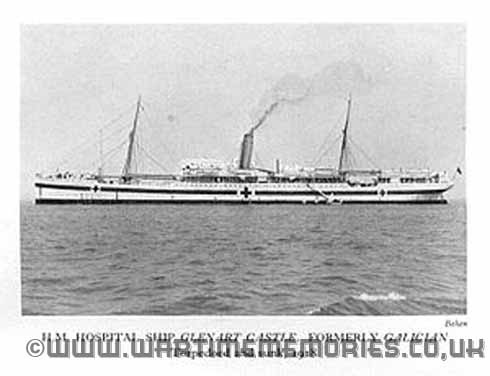|
This website uses cookies. By continuing to use this site you agree to accept cookies. If you enjoy this site please consider making a donation. 
Features Submissions Information World War 1 One ww1 wwII greatwar great 1914 1918 first battalion regiment |
The Wartime Memories Project - The Great War - Day by Day
26th February 1918
On this day:
- 27th Northumberlands disband 27th Battalion Northumberland Fusiliers disband in France.
- Hospital ship
HMHS Glenart Castle
HMHS Glenart Castle (His Majesty's Hospital Ship) was a steamship originally built as Galacian in 1900 for the Union-Castle Line. She was renamed Glenart Castle in 1914, but was requisitioned for use as a British hospital ship during the First World War. On 26 February 1918, she was hit and sunk by a torpedo from the German U-boat UC-56.
- Hospital Ship or Ambulance Transport Service during WW1.
- Medical Staff strength.
- Officers:8
- Nurses:14
- Other:59
- Accommodation capacity.
- Officers:28
- Cots:109
- Berths:316
- Period of Service as Hospital Ship or Ambulance Transport.
- Date From:30th September 1914
- Date To:26th February 1918
- Ships Crew details:
On 26 February 1918, Glenart Castle was leaving Newport, South Wales heading towards Brest, France. Fishermen in the Bristol Channel saw her clearly lit up as a hospital ship. John Hill — a fisherman on Swansea Castle — remembered "I saw the Hospital Ship with green lights all around her - around the saloon. She had her red side lights showing and mast-head light, and also another red light which I suppose was the Red Cross light. "At 0400, Glenart Castle was hit by a torpedo in the No. 3 hold. The blast destroyed most of the lifeboats, while the subsequent pitch of the vessel hindered attempts to launch the remaining boats. In the eight minutes the ship took to sink, only seven lifeboats were launched. Rough seas and inexperienced rowers swamped most of the boats.
Only a few survivors were reported. 162 people were killed including the Captain — Bernard Burt, eight nurses, seven Royal Army Medical Corps (RAMC) medical officers and 47 medical orderlies. The matron of Glenart Castle — Miss Kate Beaufoy — was a veteran of the South African War. Her family kept her diary and her writings describe life on the ship.
Evidence was found suggesting that the submarine may have shot at initial survivors of the sinking in an effort to cover up the sinking of Glenart Castle. The body of a junior officer of Glenart Castle was recovered from the water close to the position of the sinking. It was marked with two gunshot wounds, one in the neck and the other in the thigh. The body also had a life vest indicating he was shot while in the water.
Aftermath.
After the war, the British Admiralty sought the captains of U-Boats who sank hospital ships, in order to charge them with war crimes. Kapitanleutnant Wilhelm Kiesewetter — the commander of UC-56 — was arrested after the war on his voyage back to Germany and interned in the Tower of London. He was released on the grounds that Britain had no right to hold a detainee during the Armistice.
John Doran- Concert
- In the Line
- Into Billets
- Working parties
- Artillery Active
- Reliefs
- 7th Battalion, East Kent Regiment (The Buffs).
- Patrol
- Working Parties
- Enemy Heavies Active
- Working Parties
- A Courageous German
- Reliefs
- Working Parties
- Reorganisation
- Brigade Inspected
- Corps Commander Visits
- Quiet
- Training
- Demonstration
- Orders
- Reliefs
- Reliefs Complete
- Reconnaissance towards HIT
- Baths
- Range Firing
- Relieves 13th Royal Scots.
- Memo from Division
- Cleared Bosche Wood
- Baths.
Can you add to this factual information? Do you know the whereabouts of a unit on a particular day? Do you have a copy of an official war diary entry? Details of an an incident? The loss of a ship? A letter, postcard, photo or any other interesting snipts?If your information relates only to an individual, eg. enlistment, award of a medal or death, please use this form: Add a story.
Killed, Wounded, Missing, Prisoner and Patient Reports published this day.
This section is under construction.
Want to know more about 26th of February 1918?
There are:32 items tagged 26th of February 1918 available in our Library
These include information on officers, regimental histories, letters, diary entries, personal accounts and information about actions during the Great War.
Remembering those who died this day, 26th of February 1918.
Seaman Frederick Armstrong. D S M S.S. Romny. Read their Story. Able Sea. John Amos Askew. SS Dalewood Read their Story. 2nd Lt Frederick Augustus Crowley. 37 Squadron Read their Story. Add a name to this list.
Select another Date
The free section of The Wartime Memories Project is run by volunteers.
This website is paid for out of our own pockets, library subscriptions and from donations made by visitors. The popularity of the site means that it is far exceeding available resources and we currently have a huge backlog of submissions.
If you are enjoying the site, please consider making a donation, however small to help with the costs of keeping the site running.
Hosted by:
Copyright MCMXCIX - MMXXV
- All Rights Reserved -We do not permit the use of any content from this website for the training of LLMs or for use in Generative AI, it also may not be scraped for the purpose of creating other websites, books, magazines or any other forms of media.

